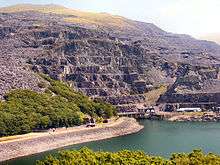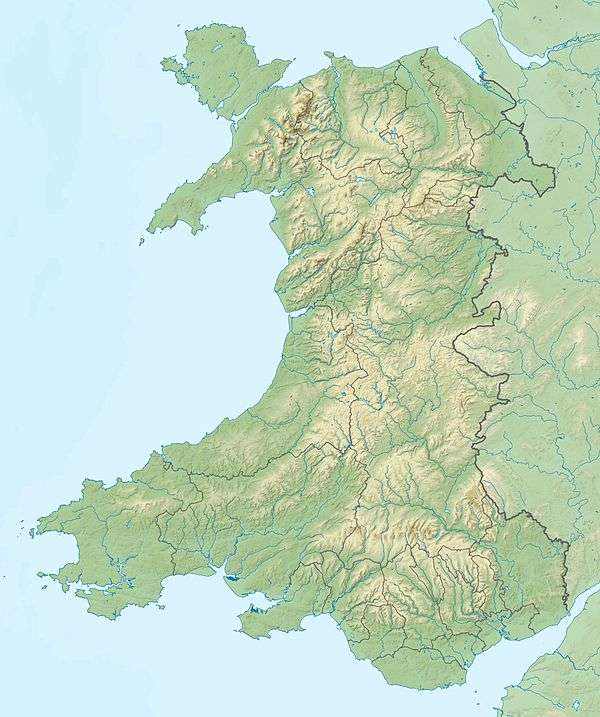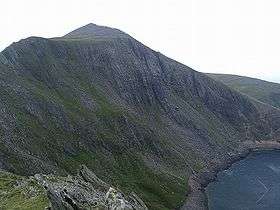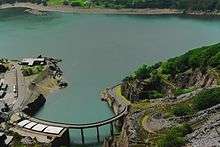Dinorwig Power Station
| Dinorwig Power Station | |
|---|---|
 Part of the power station as seen on the exterior of Elidir Fawr. | |
 Location of Dinorwig Power Station in Wales | |
| Location | Dinorwig, Wales |
| Coordinates | 53°07′07″N 04°06′50″W / 53.11861°N 4.11389°WCoordinates: 53°07′07″N 04°06′50″W / 53.11861°N 4.11389°W |
| Construction began | 1974 |
| Opening date | 1984 |
| Construction cost | £425 million |
| Reservoir | |
| Creates |
Upper: Marchlyn Mawr Lower: Llyn Peris |
| Power Station | |
| Commission date | 1984 |
| Type | Pumped-storage |
| Turbines | 6 × 300 MW (400,000 hp) |
| Installed capacity | 1,650 MW (2,210,000 hp) |
The Dinorwig Power Station (/dɪˈnɔːrwɪɡ/; Welsh: [dɪˈnɔrwɪɡ]) is a pumped-storage hydroelectric scheme, near Dinorwig, Llanberis in Snowdonia national park in Gwynedd, northern Wales. The scheme can supply a maximum power of 1,728-megawatt (2,317,000 hp) and has a storage capacity of around 9.1-gigawatt-hour (33 TJ). Its purpose is not to help meet peak loads but, as a "Short Term Operating Reserve", to provide a fast response to short-term rapid changes in power demand.
Purpose
The scheme was built in the days of the CEGB with the purpose of providing peak capacity, very rapid response, energy storage and frequency control. Dinorwig's very rapid response capability significantly reduced the need to hold spinning reserve on part loaded thermal plant. When the plant was conceived the CEGB used low efficiency old coal and oil fired capacity to meet peaks in demand. More efficient 500MW thermal sets were introduced in the 1960s initially for baseload operation only. Dinorwig could store cheap energy produced at night by low marginal cost plant and then generate during times of peak demand so displacing low efficiency plant during peak demand periods.
There were plans for a pumped storage facility near Exmoor but it was not built.[1] With the increase of renewables such as wind and solar power, the need for storage is expected to increase to deal with intermittency.[2][3][4]
Today, Dinorwig is operated not to help meet peak loads but as a STOR (Short Term Operating Reserve), providing a fast response to short-term rapid changes in power demand or sudden loss of power stations. In a common scenario (known as TV pickup), the end of a popular national television programme or advertising breaks in commercial television programmes send millions of consumers to switch on electric kettles in the space of a few minutes, leading to overall demand increases of up to 2800MW.[5] In anticipation of this surge, an appropriate number of units at Dinorwig (or other services competing for National Grid Reserve Service duty) may be brought on line as the closing credits start to roll. The monitoring of popular television channels is an important factor in electricity grid control centres.
Construction
The scheme was constructed in the abandoned Dinorwic slate quarry. To preserve the natural beauty of Snowdonia National Park, the power station itself is located deep inside the mountain Elidir Fawr, inside tunnels and caverns. The project – begun in 1974 and costing £425 million[6] and taking ten years to complete – was the largest civil engineering contract ever awarded by the UK government at the time. The work was undertaken by an Alfred McAlpine / Brand / Zschokke consortium.[7] 12,000,000 tonnes (12,000,000 long tons; 13,000,000 short tons) of rock had to be moved from inside the mountain, creating tunnels wide enough for two lorries to pass comfortably, and an enormous cavern 51 metres (167 ft) tall, 180 metres (590 ft) long, and 23 metres (75 ft) wide[8] known as "the concert hall". The power station comprises 16 kilometres (9.9 mi) of tunnels, 1 million tons of concrete, 200,000 tons of cement and 4,500 tons of steel.
The power station is connected to the National Grid substation at Pentir by 400 kV cables that are buried for approximately 10 kilometres (6 mi), rather than using transmission towers or pylons to transmit the electricity across an area of outstanding natural beauty.
A 50MW pumped storage facility at nearby Glyn Rhonwy in disused slate pits was approved in 2013, with an expected cost of £120m and an opening date in 2018.[9][10][11][12][13] It is planned to hold about 500 MWh of energy, with a round-trip efficiency of 75%.[14][15][16] The project received further approval in 2017 for an increased capacity of 100MW.[17]
Operation


Water is stored at a high altitude in Marchlyn Mawr reservoir at 636m and is discharged into Llyn Peris, at an altitude of approximately 100m, through the turbines during times of peak electricity demand. It is pumped back from Llyn Peris to Marchlyn Mawr during off-peak times. Although it uses more electricity to pump the water up than it generates on the way down, pumping is generally done at periods of low demand, when the energy is cheaper to consume.
The power station comprises six 300MW GEC generator/motors coupled to Francis-type reversible turbines. The generators are vertical shaft, salient pole, air cooled units each having 12 electromagnetic poles weighing 10 tonnes each, producing a terminal voltage of 18 kV, synchronous speed is 500 rpm. From standstill, a single 450-tonne generator can synchronise and achieve full load in approximately 75 seconds. With all six units synchronised and spinning-in-air (Water is dispelled by compressed air and the unit draws a small amount of power to spin the shaft at full speed), 0 MW to 1800 MW load can be achieved in approximately 16 seconds.[18] Once running, at full flow, the station can provide power for up to 7 hours before running out of water.[19]
The energy storage capacity of the station is approximately 9.1 GWh.[20] At peak output water flows through the generators at 390 cubic metres per second (about the volume of a 25m swimming pool every second).[21]
Another important feature of Dinorwig is that it has been designed to assist restarting the National Grid on the occasion of a complete power failure (a black start). It includes diesel generators and large batteries which would allow the plant to restart even in the event of a complete shutdown of the grid (Dinorwig is not unique in this respect as some fossil-fuel plants are also able to self-start).
The plant runs on average at 74–76% efficiency.[22][23] It fills an important need in the system by responding to sudden surges in electricity demand because of its rapid ability to deliver power on load spikes. One of the alternatives would be to have spare capacity from conventional power stations running part loaded ("spinning reserve"), hence at lower efficiency than otherwise, and thus capable of being rapidly run up to full load. This would mean generating an additional 1330–1590 GWh of power each year and releasing more than 140,000 tonnes of CO2 into the atmosphere each year.. Other forms of power plant compete in this market for reserve power such as gas turbines and diesel generators for the National Grid Reserve Service.
Excess water overflows to Llyn Padarn and is lost from the Reservoir system. Both Llyn Peris and Llyn Padarn were ancestral homes to the Arctic char, a rare fish in the UK. When the scheme was commissioned, a fish rescue was undertaken to transfer the char from Llyn Peris to other local suitable lakes and it is believed that due to the very variable water levels in Llyn Peris, Arctic char are now absent from the lake.
The power station is also promoted as a tourist attraction, with visitors able to take a minibus trip from "Electric Mountain" - the name of its nearby visitor centre - to see the workings inside the power station;[24][23] 132,000 people visited the attraction in 2015.[25]
See also
References
- ↑ "Grid-connected energy storage: a new piece in the UK energy puzzle – The Engineer The Engineer". www.theengineer.co.uk.
- ↑ "Understanding the Balancing Challenge" Imperial College London, August 2012. Retrieved: 22 January 2015. Size: 3.7MB in 115 pages.
- ↑ "Strategic Assessment of the Role and Value of Energy Storage Systems in the UK Low Carbon Energy Future" Imperial College London, June 2012. Retrieved: 22 January 2015. Size: 4.5MB in 108 pages.
- ↑ Holmes, Dave. "A closing window of opportunity" Quarry Battery Company, 26 August 2014. Retrieved: 22 January 2015.
- ↑ "National Grid leaflet: "Forecasting Demand"" (PDF).
- ↑ Dinorwig – The Electric Mountain, Elaine Williams, A National Grid Publication, 1991
- ↑ Gray, p. 14
- ↑ International Power Archived 12 May 2016 at the Wayback Machine.
- ↑ Iolo ap Dafydd. "Glyn Rhonwy quarry lake: Gwynedd power plan approved" BBC News, 2 September 2013. Retrieved: 21 January 2015.
- ↑ Kavanagh, Michael. "Green light for Welsh hydroelectric power station" Financial Times, 6 September 2013. Retrieved: 21 January 2015.
- ↑ "Wales developer wins funding for initial work at 49.4-MW Glyn Rhonwy Pumped-Storage" HydroWorld, 29 September 2014. Retrieved: 21 January 2015.
- ↑ "Glyn Rhonwy quarry lake: Project receives £3m" BBC News, 24 September 2014. Retrieved: 21 January 2015.
- ↑ Anderson, Catherine. "Pumped storage: what are its prospects?" AECOM / International Water Power and Dam Construction. Global Trade Media, 13 June 2014. Retrieved: 21 January 2015.
- ↑ "Fact Sheet: The History of Glyn Rhonwy" Archive Quarry Battery Company
- ↑ "Glyn Rhonwy Project website 1".
- ↑ "Glyn Rhonwy Project website 2".
- ↑ "Green light for Welsh storage". 8 March 2017. Retrieved 14 March 2017.
- ↑ First Hydro webpage Archived 12 May 2016 at the Wayback Machine.
- ↑ Mountain, Electric. "Electric Mountain - Dinorwig Power Station". www.electricmountain.co.uk.
- ↑ MacKay, David JC (2009). Sustainable Energy - without the hot air. Cambridge: UIT. p. 191. ISBN 978-0-9544529-3-3.
- ↑ Gilbert, Jeffrey. "Volume Of A Swimming Pool". Retrieved 3 December 2017.
- ↑ "First Hydro Analysts Conference" (PDF).
- 1 2 SA Mathieson (16 May 2016). "Inside Electric Mountain: Britain's biggest rechargeable battery". The Register. Retrieved 27 June 2016.
- ↑ Mountain, Electric. "Electric Mountain - Home". electricmountain.co.uk.
- ↑ "Wales Visitor Attractions Survey 2015" (PDF). Welsh Government: Visits to Tourist Attractions. Retrieved 16 February 2017.
Sources
- Gray, Tony (1987). The Road to Success: Alfred McAlpine 1935–1985. Rainbird Publishing.
External links
| Wikimedia Commons has media related to Dinorwig pumped storage scheme. |
